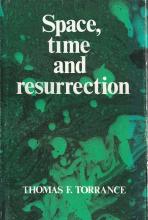Thomas F. Torrance, Space, Time and Resurrection (Edinburgh: Handsel Press, 1976); #1976-331
Torrance, Thomas F. Space, Time and Resurrection. Edinburgh: Handsel Press, 1976; #1976-331
First edition.
Begun as a sequel to Space, Time and Incarnation, but that effort led to the Harris Lectures entitled "God and the Universe," published as Reality and Scientific Theology (1985, #1985-450). Preface: "Here, however, I have contented myself with presenting an account of the resurrection and ascension of Christ in a form that has grown out of my teaching in the University of Edinburgh..." (p. xii).
This book is part of a trilogy within a trilogy on hermeneutics. This is one of five works Torrance conceived as a sequence on the history of hermeneutics. In the Prefaces to Divine Meaning (#1995-588) and The Hermeneutics of John Calvin (#1988-488), Torrance explains that he had originally projected a three-volume work on the hermeneutics of the Fathers, of Calvin, and of the Moderns. Divine Meaning (#1995-588) and The Hermeneutics of John Calvin (#1988-488) comprise the first two volumes of the trilogy, respectively. The third volume on the hermeneutics of the moderns was realized in a sub-trilogy of works: Space, Time and Incarnation (#1969-262); Space, Time and Resurrection (#1976-331), and Reality and Evangelical Theology (#1982-397). Torrance's intent with the larger trilogy was to focus on "the history of hermeneutical thought in which particular attention was devoted to the epistemological issues involved" (Divine Meaning Preface, p. 1). Regarding the "moderns" trilogy within a trilogy, Torrance explains (Calvin Preface, p. vii): "Some of the main problems that have arisen in modern hermeneutics have been discussed in" them.
Dedicated to James S. Stewart.
Preface, ix. (#1976-331a)
Introduction, 1. (#1976-331b)
Ch. 1: The Biblical Concept of the Resurrection, 27. (#1976-331c)
Ch. 2: The Resurrection and the Person of Christ, 46. (#1976-331d)
Ch. 3: The Resurrection and the Atoning Work of Christ, 61. (#1976-331e)
Ch. 4: The Nature of the Resurrection Event, 86. (#1976-331f)
Ch. 5: The Ascension of Christ, 106. (#1976-331g)
Ch. 6: The Nature of the Ascension Event, 123. (#1976-331h)
Ch. 7: The Ascension and the Parousia of Christ, 143. (#1976-331i)
Ch. 8: The Lord of Space and Time, 159. (#1976-331j)
Index of Names, 195.
“He who was made flesh is the Creator Logos by whom all things were made and in whom all things are upheld. When he became incarnate, and divine and human natures were united in his one person, his humanity was brought into an ontological relation with all creation. So far as our humanity is concerned that means that all men are upheld, whether they know it or not, in their humanity by Jesus Christ the true and proper man, upheld by the fulfilment and establishment of true humanity in him, but also through his work in the cross and resurrection in which he overcame the degenerating forces of evil and raised up our human nature out of death and perdition. But the range of Christ's mighty acts in incarnation, reconciliation and resurrection apply to the whole universe of things, visible and invisible. The whole of creation falls within the range of his Lordship, as he works out his purpose by bringing redemption together with creation, and actualizing the holy will of the Father in everything. Eschatology has here a teleological relation to the whole realm of created existence, and leads into the doctrine of ‘the new heaven and the new earth’. God does not abandon his creation when he has saved man, for all creation, together with man, will be renewed when Christ comes again. Since he is the first-born of the new creation, the head in whom all things, visible and invisible, are reconciled and gathered up, the resurrection of Christ in body becomes the pledge that the whole physical universe will be renewed, for in a fundamental sense it has already been resurrected in Christ.” (pp. 154-155)
- PTS copy.
- Oklahoma History of Science Collections copy donated by Bruce Ritchie.
- 906 views

